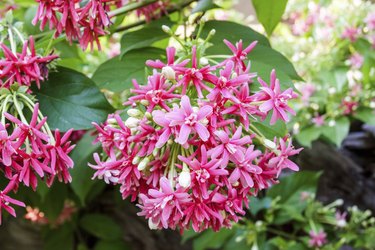
Most flowering plants have blossoms whose colors fade as they age, but the Rangoon creeper (Quisqualis indica) does exactly the opposite, with flowers opening white, then turning pink and eventually becoming dark red, all in three days. A tender tropical vine, it grows in U.S. Department of Agriculture plant hardiness zones 10 through 12, and can also be container-grown indoors. The vine can be 70 feet tall under ideal conditions, but trimming it regularly and at the right time helps keep it bushy and its size under control.
Semi-Dormant Pruning
Video of the Day
The Rangoon creeper is an evergreen that becomes semi-dormant when weather turns cool. During this time, it stops growing and takes a rest, so it's best to trim a plant back near the end of winter or in very early spring, when it's poised to put out new growth. Cutting just before new growth appears stimulates a flush of new shoots, which promotes heavy flowering because buds of this plant form on new growth. Cut back individual vines to any length you wish, even back to the ground to re-invigorate an older plant. Clean your pruning blades by wiping them with rubbing alcohol between cuts to prevent spread of plant diseases. For a large plant, unwind vines from each other first, so that you have a clear picture of which stem you're going to cut.
Video of the Day
Other Times
Rangoon creeper prefers full sun, but can also tolerate some shade. In cooler parts of its growing zones, it's best to grow the plant in a warm spot, such as near a south- or west-facing wall of a building. Although it tolerates temperatures as low as 20 degrees Fahrenheit for short periods, unusually long cold spells can cause it to drop some leaves, while terminal ends of the vines might be damaged and die back. Trim the vine whenever this happens, even during the winter, cutting into healthy tissue just behind the damaged part of the vine. Besides keeping the plant tidy, pruning when damage appears helps prevent dying tissues from developing disease.
Summer Trimming
While the Rangoon creeper is actively growing in spring and summer, you can promote a shorter, bushier form by pinching back growing tips of young vines. This stimulates branching and restricts the height of a vine while increasing its spread. For an indoor-grown plant, you can do general trimming at any time to control vine length and keep the plant bushy, but reserve hard pruning for late winter or early spring. Because tendrils don't form on this plant, when new growth appears, tie it to the plant's support with soft ties and train vines around it as they get longer. While you're training the plant, cut back or remove any vines that don't conform to the trellis, allowing others that twine readily to remain.
Care After Trimming
After you've trimmed a Rangoon creeper, give the vine a bit of extra care to help it put out healthy new growth. Keep the plant's soil evenly moist, giving it at least 1 inch of water weekly, including rain. Add a 3- or 4-inch thick layer of organic mulch under its canopy, to help conserve soil moisture and discourage weeds, but keep mulch away from the bases of the vines to prevent fungal problems. Feed the plant monthly during spring and summer with a balanced, 10-10-10 water-soluble fertilizer, diluted at a rate of 1/4 teaspoon per gallon of water, but check your product label for additional directions.